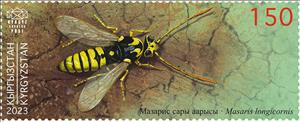Stamp: Kuznetzov’s Longicorn Wasp (Masaris longicornis) (Kyrgyzstan- Kyrgyz Express Post 2024)
Kuznetzov’s Longicorn Wasp (Masaris longicornis) (Kyrgyzstan- Kyrgyz Express Post 2024)
30 April (Kyrgyzstan- Kyrgyz Express Post ) within release Insects of Kyrgyzstan (2024) goes into circulation Stamp Kuznetzov’s Longicorn Wasp (Masaris longicornis) face value 150 Kyrgyzstani som
| Stamp Kuznetzov’s Longicorn Wasp (Masaris longicornis) in catalogues | |
|---|---|
| Colnect codes: | Col: KG-EX 2024.04.30-12 |
Stamp is horizontal format.
Dated 2023Also in the issue Insects of Kyrgyzstan (2024):
- Stamp - Galatea Tiger Beetle (Cephalota galatea) face value 75;
- Full Pane - Galatea Tiger Beetle (Cephalota galatea) face value 5*75;
- Souvenir Sheet - Insects of Kyrgyzstan face value 575;
- Souvenir Sheet - Kirghizobia Longicorn Beetle (Kirgizobia bohnei) face value 300;
- Stamp - Kirghizobia Longicorn Beetle (Kirgizobia bohnei) face value 300;
- Stamp - Kuznetzov’s Longicorn Wasp (Masaris longicornis) face value 150;
- Full Pane - Kuznetzov’s Longicorn Wasp (Masaris longicornis) face value 5*150;
- Stamp - Matriarchal Katydid (Saga pedo) face value 50;
- Full Pane - Matriarchal Katydid (Saga pedo) face value 5*50;
- Stamp - Southern Swallowtail (Papilio alexanor) face value 300;
- Full Pane - Southern Swallowtail (Papilio alexanor) face value 5*300;
Stamp Kuznetzov’s Longicorn Wasp (Masaris longicornis) it reflects the thematic directions:
Insects (from Latin insectum, a calque of Greek ἔντομον [éntomon], "cut into sections") are a class (Insecta) of hexapod invertebrates within the arthropod phylum that have a chitinous exoskeleton, a three-part body (head, thorax and abdomen), three pairs of jointed legs, compound eyes and one pair of antennae. They are the most diverse group of animals on the planet, including more than a million described species and representing more than half of all known living organisms. The number of extant species is estimated at between six and ten million, and potentially represent over 90% of the differing animal life forms on Earth. Insects may be found in nearly all environments, although only a small number of species reside in the oceans, a habitat dominated by another arthropod group, crustaceans. The life cycles of insects vary but most hatch from eggs. Insect growth is constrained by the inelastic exoskeleton and development involves a series of molts. The immature stages can differ from the adults in structure, habit and habitat, and can include a passive pupal stage in those groups that undergo 4-stage metamorphosis (see holometabolism). Insects that undergo 3-stage metamorphosis lack a pupal stage and adults develop through a series of nymphal stages. The higher level relationship of the Hexapoda is unclear. Fossilized insects of enormous size have been found from the Paleozoic Era, including giant dragonflies with wingspans of 55 to 70 cm (22–28 in). The most diverse insect groups appear to have coevolved with flowerin plants.

